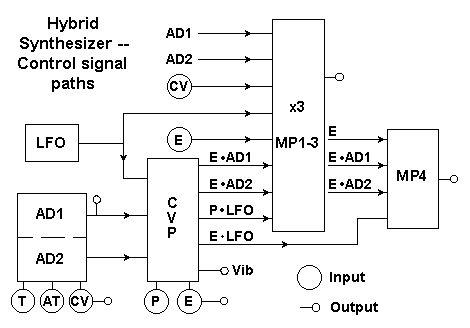| Analog Parameter Settings |
| Module |
Parameters |
| AD1,2 |
Att. t, Dec. t, Delay t, CV scaling |
| LFO |
Freq. |
| CVP |
Vib. amount |
| MP1-3 |
(E x)AD1, (E x)AD2, LFO, P x LFO, E, CV (mix) |
| MP4 |
E x AD1, E x AD2, E x LFO, E (mix) |
| VCO1 |
Init. F, FM depth |
| DPWG |
PW, PWM depth, PP, PPM depth |
| VCO2 |
Init. F, FM depth, PW |
| AMX1 |
Saw1, Tri1, DP, Saw2, Tri2, VCF2 (mix) |
| AMX2 |
Saw1, Tri1, DP, Saw2, Tri2, Pul2 (mix) |
| VCF1,2 |
Init. F, Q, FM depth |
| VCA2 |
Init. A, AM depth |
The system's computer interface sets and holds 63 analog voltages which establish various voltage-controlled parameters in both the audio and control sections, as discussed above. A complete listing of these is given in the second table. There are just a couple of points to be specially noted in this table. First, the AD generators have voltage controlled delay times and their rates can be scaled to the main control voltage CV. Second, the width and relative position of the DPWG pulses are under voltage control. Thus pulse position modulation is available in addition to the more familiar pulse width modulation. The remaining functions should be self-explanatory to those familiar with standard synthesis techniques.



